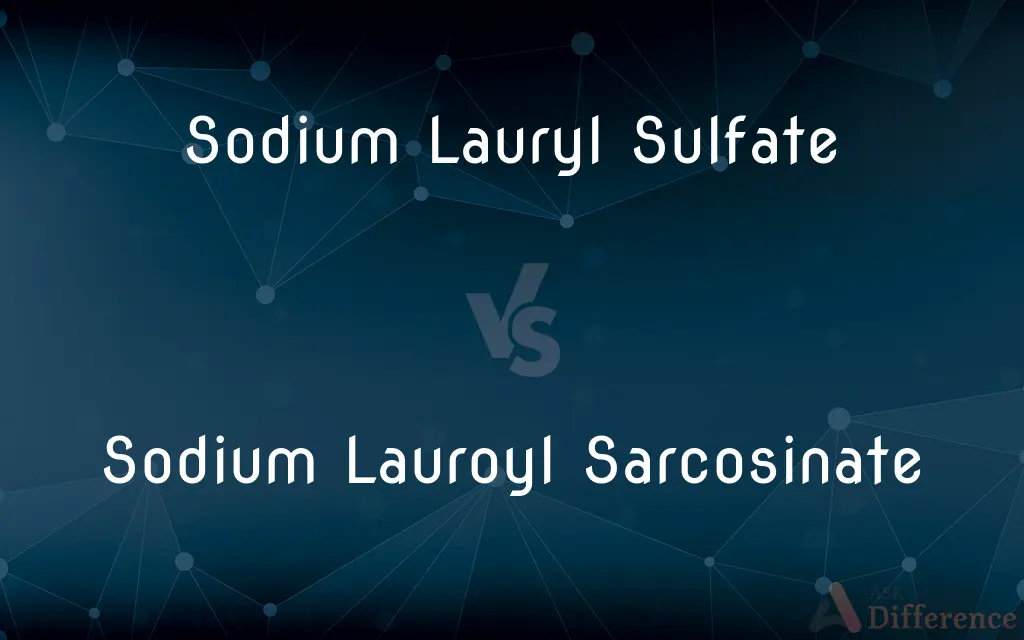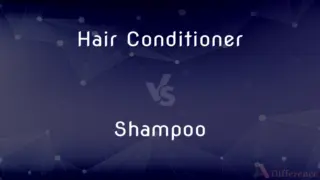Sodium Lauryl Sulfate vs. Sodium Lauroyl Sarcosinate — What's the Difference?
By Tayyaba Rehman — Published on January 15, 2024
Sodium Lauryl Sulfate is a harsh surfactant used in cleaning products, while Sodium Lauroyl Sarcosinate is a milder, skin-friendly surfactant.

Difference Between Sodium Lauryl Sulfate and Sodium Lauroyl Sarcosinate
Table of Contents
ADVERTISEMENT
Key Differences
Sodium Lauryl Sulfate (SLS) is a widely used surfactant in various personal care and cleaning products. It is known for its effective cleaning and foaming properties. SLS is a strong detergent and can strip oils, leading to potential skin irritation. In contrast, Sodium Lauroyl Sarcosinate is a gentler surfactant derived from sarcosine, a natural amino acid. This ingredient is also used in personal care products but is milder and less irritating to the skin compared to SLS.
In terms of chemical structure, SLS is a sulfate, which makes it a more aggressive cleaning agent and more effective at removing oils and dirt. However, this aggressiveness can also disrupt the skin's natural barrier, causing dryness and irritation. Sodium Lauroyl Sarcosinate, on the other hand, is a sarcosinate, a milder type of surfactant that is more compatible with the skin's natural components, reducing the risk of irritation.
When it comes to usage in products, SLS is commonly found in shampoos, toothpaste, and laundry detergents, where strong cleaning is desired. Sodium Lauroyl Sarcosinate is typically used in products formulated for sensitive skin, like gentle facial cleansers, body washes, and shampoos for frequent use.
Environmental and health considerations also differ between these two ingredients. SLS has been scrutinized for its potential environmental impact and health concerns, leading some consumers to seek SLS-free products. Sodium Lauroyl Sarcosinate is generally considered a safer and more environmentally friendly alternative due to its milder nature and biodegradability.
In summary, while both Sodium Lauryl Sulfate and Sodium Lauroyl Sarcosinate are surfactants used in personal care and cleaning products, they differ significantly in their strength, potential for skin irritation, and environmental impact. SLS is a stronger detergent suitable for heavy-duty cleaning, while Sodium Lauroyl Sarcosinate is a gentler alternative better suited for sensitive skin.
ADVERTISEMENT
Comparison Chart
Chemical Type
Sulfate
Sarcosinate (derived from amino acid)
Cleaning Strength
Strong and aggressive
Milder and less irritating
Usage in Products
Found in shampoos, toothpaste, detergents
Used in gentle cleansers and sensitive skin products
Skin Irritation Potential
Higher potential for irritation
Lower potential for irritation
Environmental Impact
Greater scrutiny for environmental concerns
Considered more environmentally friendly
Compare with Definitions
Sodium Lauryl Sulfate
Sodium Lauryl Sulfate is a strong surfactant used in cleaning products.
The foaming action in this shampoo is due to Sodium Lauryl Sulfate.
Sodium Lauroyl Sarcosinate
Sodium Lauroyl Sarcosinate is less irritating than SLS.
Sodium Lauroyl Sarcosinate is a better choice for sensitive skin products.
Sodium Lauryl Sulfate
SLS can be harsh and cause skin irritation.
I avoid Sodium Lauryl Sulfate in skincare due to its potential to irritate my skin.
Sodium Lauroyl Sarcosinate
Sodium Lauroyl Sarcosinate is compatible with sensitive skin.
Sodium Lauroyl Sarcosinate in this body wash helps prevent skin irritation.
Sodium Lauryl Sulfate
SLS is a widely used sulfate in personal care products.
Many commercial shampoos contain Sodium Lauryl Sulfate for its cleansing power.
Sodium Lauroyl Sarcosinate
Sodium Lauroyl Sarcosinate is used in mild shampoos and body washes.
This baby shampoo uses Sodium Lauroyl Sarcosinate for its mildness.
Sodium Lauryl Sulfate
SLS is known for its effective grease-cutting properties.
Sodium Lauryl Sulfate in the detergent removes tough stains effectively.
Sodium Lauroyl Sarcosinate
Sodium Lauroyl Sarcosinate is biodegradable and environmentally friendly.
I prefer products with Sodium Lauroyl Sarcosinate for their eco-friendliness.
Sodium Lauryl Sulfate
Sodium Lauryl Sulfate is a common ingredient in toothpaste.
SLS helps create the foamy texture in many toothpaste brands.
Sodium Lauroyl Sarcosinate
Sodium Lauroyl Sarcosinate is a mild surfactant derived from sarcosine.
My facial cleanser contains Sodium Lauroyl Sarcosinate for gentle cleaning.
Common Curiosities
Why is SLS considered harsh?
SLS can strip natural oils from skin and hair, leading to dryness and irritation.
Is Sodium Lauroyl Sarcosinate better for sensitive skin?
Yes, it's milder and less likely to irritate sensitive skin compared to SLS.
Is SLS safe in toothpaste?
SLS is generally considered safe in toothpaste, but some may prefer SLS-free options.
Should people with eczema avoid SLS?
Yes, individuals with eczema or sensitive skin may benefit from avoiding SLS.
What is Sodium Lauryl Sulfate (SLS)?
SLS is a surfactant used in various cleaning and personal care products.
Can SLS cause allergic reactions?
Some people may experience allergic reactions or skin irritation from SLS.
What is Sodium Lauroyl Sarcosinate?
Sodium Lauroyl Sarcosinate is a mild surfactant derived from an amino acid, used in gentle cleansing products.
Is Sodium Lauroyl Sarcosinate safe for everyday use?
Yes, it's considered safe and gentle for daily use in personal care products.
Can Sodium Lauroyl Sarcosinate cause dryness?
It's less likely to cause dryness compared to SLS due to its mild nature.
Is Sodium Lauroyl Sarcosinate suitable for all skin types?
It's generally suitable for all skin types, especially those with sensitive skin.
Are there environmental concerns with SLS?
SLS has faced scrutiny for its potential environmental impact and biodegradability.
Does SLS affect hair health?
Prolonged use of SLS can strip hair of natural oils, potentially affecting hair health.
Is Sodium Lauroyl Sarcosinate a natural ingredient?
It's derived from a natural amino acid, making it a more natural option.
Can I find SLS-free personal care products?
Yes, there are many SLS-free alternatives available on the market.
Is Sodium Lauroyl Sarcosinate vegan?
It's typically derived from plant sources, making it suitable for vegans.
Share Your Discovery

Previous Comparison
Register vs. Memory
Next Comparison
Hair Conditioner vs. ShampooAuthor Spotlight
Written by
Tayyaba RehmanTayyaba Rehman is a distinguished writer, currently serving as a primary contributor to askdifference.com. As a researcher in semantics and etymology, Tayyaba's passion for the complexity of languages and their distinctions has found a perfect home on the platform. Tayyaba delves into the intricacies of language, distinguishing between commonly confused words and phrases, thereby providing clarity for readers worldwide.












































